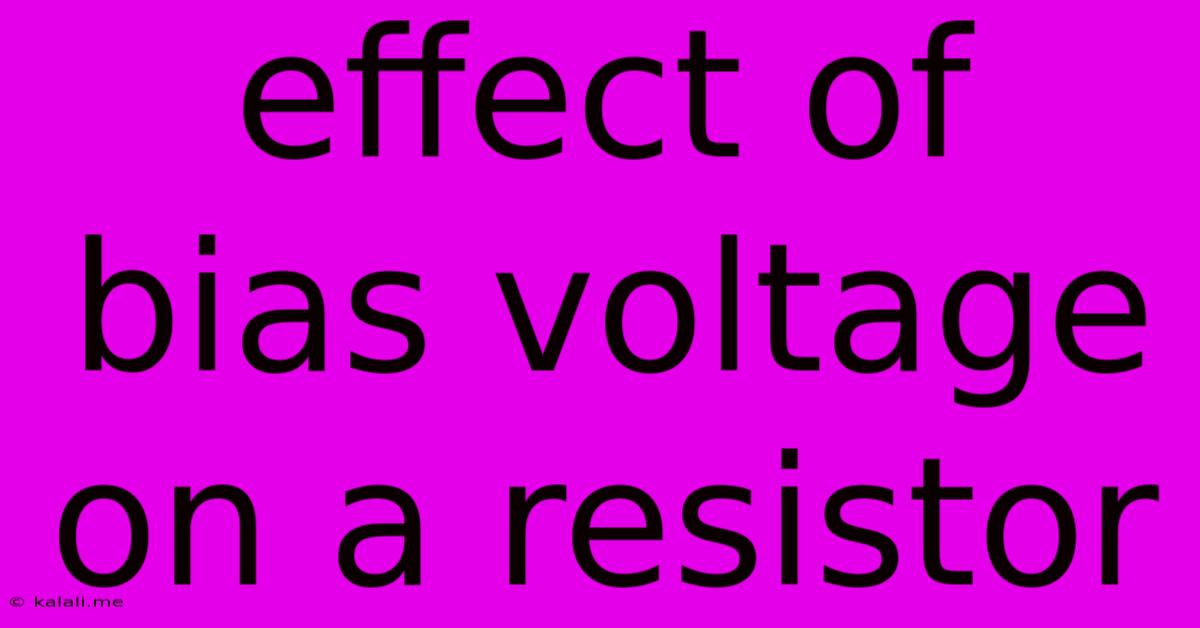Effect Of Bias Voltage On A Resistor
Kalali
May 29, 2025 · 4 min read

Table of Contents
The Effect of Bias Voltage on a Resistor: More Than Meets the Eye
The relationship between voltage and current in a resistor is fundamental to basic electronics, often simplified to Ohm's Law: V = IR. This seemingly straightforward equation suggests a linear relationship, implying that the resistor's behavior remains constant regardless of the applied voltage. However, the reality is more nuanced. While Ohm's Law serves as an excellent approximation for a wide range of applications, the effect of bias voltage on a resistor can be significant under certain circumstances, particularly at extreme voltage levels or with specific resistor types. This article delves into these effects, exploring how bias voltage can impact resistor performance and what considerations engineers should keep in mind.
Understanding the Ideal Resistor
In an ideal resistor, the resistance (R) remains constant irrespective of the applied voltage (V) or the resulting current (I). This means the resistor's resistance value printed on its body accurately reflects its behavior under all operating conditions. This is the basis of Ohm's Law, which is crucial for circuit analysis and design. However, it's important to remember that this is a theoretical model.
Real-World Resistor Limitations and the Impact of Bias Voltage
Real-world resistors deviate from ideal behavior due to several factors, and the applied bias voltage plays a crucial role:
1. Temperature Effects:
-
Self-Heating: As current flows through a resistor, it dissipates power as heat (P = I²R). This heat increases the resistor's temperature. Most resistor materials exhibit a positive temperature coefficient (PTC), meaning their resistance increases with temperature. Higher bias voltages lead to higher currents and consequently greater self-heating, resulting in a measurable increase in resistance. This effect is more pronounced in low-power resistors. This is also known as thermal runaway.
-
Ambient Temperature: Changes in the surrounding environment's temperature also affect the resistor's resistance. This is particularly relevant in applications with varying operating conditions.
2. Non-Linearity:
- Material Properties: At very high voltages, the material of the resistor may exhibit non-linear behavior, deviating from Ohm's Law. The relationship between voltage and current might no longer be linear. This is more common in certain types of resistors, such as those made from non-metallic materials.
3. Power Rating:
- Exceeding Power Limits: Resistors have a specified power rating. Applying a bias voltage that exceeds this rating will cause excessive heat generation, leading to irreversible damage (burnout) or significant and permanent changes in the resistor's resistance value. The resistor's power dissipation capacity is crucial, and exceeding this limit will lead to its failure.
4. Voltage Coefficient:
- Voltage Dependence: Some resistor types have a voltage coefficient (VC), which describes the change in resistance with respect to the applied voltage. While often negligible at lower voltages, this effect becomes more noticeable at higher voltages. This is particularly relevant in high-precision applications.
5. Type of Resistor:
- Resistor Material and Construction: The type of resistor (e.g., carbon film, metal film, wire-wound) significantly impacts its sensitivity to bias voltage. Wire-wound resistors, for instance, tend to be more stable and less affected by voltage changes than carbon film resistors.
Practical Considerations and Mitigation Strategies
For most applications, the effect of bias voltage on a resistor is minimal and can be safely ignored. However, for precision circuits, high-power applications, or those operating in extreme environments, it is crucial to consider these effects. Some mitigation strategies include:
- Selecting appropriate resistors: Choosing resistors with a higher power rating and a low temperature coefficient helps minimize the impact of self-heating and temperature variations.
- Heat sinking: For high-power applications, using heat sinks helps dissipate heat and maintain a stable operating temperature.
- Using more stable resistor types: Metal film or wire-wound resistors are generally more stable than carbon film resistors.
- Derating: Operating resistors below their maximum power rating provides a safety margin and reduces the impact of self-heating.
- Temperature compensation: In some cases, using temperature-compensating components can help mitigate temperature-related changes in resistance.
In conclusion, while Ohm's Law provides a fundamental understanding of the resistor-voltage relationship, real-world resistors exhibit complexities influenced by the applied bias voltage. Understanding these effects, particularly temperature dependence and power handling limitations, is crucial for accurate circuit design and reliable system performance. Choosing the right resistor for the specific application is key to mitigating these effects and ensuring optimal system operation.
Latest Posts
Latest Posts
-
Can You Take A Lighter On An Airplane
May 30, 2025
-
How To Make 3 4 Pvc Pipe Into Strong Handle
May 30, 2025
-
Definition Contour Integral Union Of Curves
May 30, 2025
-
How Do You Say Peas In Spanish
May 30, 2025
-
Baking Soda Is An Acid Or Base
May 30, 2025
Related Post
Thank you for visiting our website which covers about Effect Of Bias Voltage On A Resistor . We hope the information provided has been useful to you. Feel free to contact us if you have any questions or need further assistance. See you next time and don't miss to bookmark.